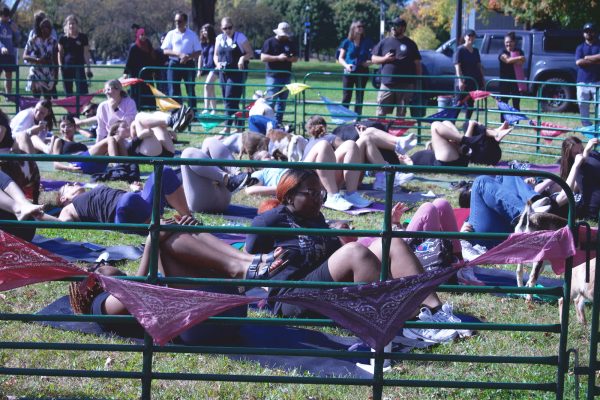Students cope with switch to online learning
After Oakland University officially moved most classes online on Monday, Nov. 16, students are coping with online tuition and dwindling in-person discussion. Some are building new connections with these common challenges though — professors and students.
Oakland University’s health concerns
There was a surge in COVID-19 cases related to the campus community this month, which prompted a warning from President Ora Hirsch Pescovitz on Friday, Nov. 6. The switch to online was confirmed on Monday, Nov. 9. There was roughly one new case reported each day in October, and OU’s average increased to roughly 10 new cases per day in November.
“We have seen an increased number of COVID-19 cases occurring within our campus community,” Pescovitz said in the official email. “This suggests that some of us have become more complacent in our efforts to protect ourselves and one another.”
Increased online classes is meant to lower in-person contact and the spread of COVID-19. Previously, 37% of students reported they would not be returning to campus this semester and 21% only returning for classes, according to an Oakland Post poll in September. Those statistics suggest the majority of students (58%) will not be on campus going forward. However, this isn’t a choice exclusively for OU. After Gov. Gretchen Whitmer’s address on Sunday, Nov. 16, all learning — K-12 and college-level — will resume virtually on Wednesday, Nov. 18, two days after OU moved online.
“This virus spreads most rapidly in community settings, especially when we tend to let down our guard,” Pescovitz said in the official email. “This means that we must remain vigilant, not only when we are on the OU campus, but everywhere we go.”
Tuition and online class
Psychology major Kacie Roggenbuck agrees with the move to online learning. Although she “struggled” taking online classes, Roggenbuck chose to stay off campus this semester to avoid exposure to more people.
Even so, Roggenbuck is concerned about the cost of her online classes. The university did introduce a tuition freeze to combat the financial hardship many students are feeling because of the pandemic, but Roggenbuck expected a lower online rate and feels “taken advantage of [by OU].”
Tuition funds almost 80% of OU’s operating revenue, making it a primary source of income. Students were offered additional financial assistance from individual financial aid and the CARES Act, but many students still feel a financial burden from online classes this year.
Types of classes
Most students are navigating solely synchronous and asynchronous online classes. A synchronized class takes place at a set time, most similar to an in person class, while an asynchronous class involves more individual time management, with a string of online assignments and activities throughout each week.
There are some exceptions to this format made for “labs, lab-based research and field experience,” according to the official Campus Communication email.
Communication major Teyler Thompkins prefers asynchronized classes because “without actually being there” class meetings don’t offer the same “engagement.” Because she has to use a computer for work and school, she “spends the majority of [her] day staring at a screen” and prefers controlling when she logs online.
Similarly, electrical engineering major Brandon Birge has noticed students struggle to give the “same amount of engagement” in synchronized virtual meetings. His classes include math concepts, and pacing can be difficult with varied participation and network connection issues.
“In terms of understanding the content of the lectures, I don’t feel like I’m learning as efficiently,” Birge said.
Even so, asynchronous learning isn’t always a solution. Communication major Brendan Triola prefers a mix of asynchronous and synchronous classes.
“I wouldn’t be able to manage my time well enough…” Triola said. “Otherwise I would just get overwhelmed at the end of the week because I just procrastinate.”
Professor accommodations
While students confront challenges in online learning, Triola noted professors are going through similar challenges. Some professors hadn’t taught in an online format until last spring when COVID-19 safety precautions first pushed class online.
“Professors are getting better at online [class], and hopefully next semester classes will be more enjoyable,” Triola said. “I don’t think anyone would describe this semester as enjoyable because we were rushed into moving online.”
Psychology major Kerstyn Sass appreciates her professors have been flexible with deadlines and assignments, allowing her to “create her own schedule.” Students and professors are adapting together, and “time management” and “communication” are the keys to online learning, according to Sass.
Professors have been “very accommodating” with assignments and projects in Birge’s classes too, but some aspects out of their hands. According to Birge, some labs have been “shut down,” despite being one of the only in-person classes left.
Although students and professors have different roles, both are experiencing the pandemic in some way. Online classes are an adjustment for students and professors that prefer in-person classes.
“It feels like it just started, but it also feels like it’s never going to end,” Triola said.






